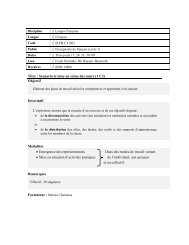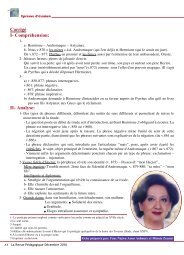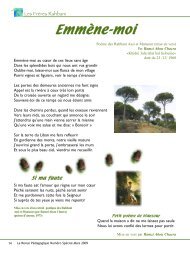Hasan Kamel Al Sabbah - CRDP
Hasan Kamel Al Sabbah - CRDP
Hasan Kamel Al Sabbah - CRDP
You also want an ePaper? Increase the reach of your titles
YUMPU automatically turns print PDFs into web optimized ePapers that Google loves.
work. He was engaged in work on<br />
television and motors as well, and<br />
originated circuits for use with rectifiers.<br />
He wrote a series of articles on polyphase<br />
polycyclic static converters which were<br />
published in the General Electric Review<br />
and presented a paper on the effect of<br />
circuits on arc backs to the Mercury<br />
Congress at Paris in 1932. He was also on<br />
the fellowship list of the Institute of<br />
Electrical and Electronics Engineers. His<br />
inventions in electricity had a great impact<br />
on the development of 20th Century<br />
technology.<br />
<strong>Al</strong>-<strong>Sabbah</strong>’s dream was to build sunpowered<br />
cells in the Arabian Desert. The<br />
main ingredients for solar power are the<br />
ubiquitous sand which is used to make<br />
solar cells and the strong sun for powering<br />
them. In 1935, he declared that he would<br />
return to the Middle East and transform the<br />
Arabian Desert into a paradise. He<br />
intended to use the desert to generate and<br />
power the solar cells thus producing<br />
enormous amounts of energy.<br />
<strong>Al</strong>-<strong>Sabbah</strong>'s inventions and patents have<br />
contributed to applied technology in North<br />
America and the entire world. His patents<br />
in highly intricate systems, instruments and<br />
equipment are classified over six main<br />
categories as follows:<br />
1-Space Industry (The Solar Power)<br />
27 patents awarded between 1928 and<br />
1935. These are widely used for space as a<br />
main source of power for vehicles and<br />
satellites. The original solar cell which was<br />
invented and tested by <strong>Al</strong>-<strong>Sabbah</strong> was<br />
41 La Revue Pédagogique Avril 2011<br />
further developed after World War II by<br />
Bell Telephone Laboratories in 1955. A<br />
careful review of aircraft, spaceship, and<br />
satellite electric systems reveal that many<br />
electronic instruments and equipments<br />
such as integrators, regulators, inverters,<br />
timers, transmitters, and sensors were<br />
developed from his original inventions of<br />
rectifiers and converters.<br />
2-Automotive Industry (The Solar<br />
Electric Car)<br />
There are five basic patents (1929-35)<br />
on electric distribution, transforming and<br />
translating circuits. In 1930, he performed<br />
experiments on his own car to electrify it.<br />
He worked to make the idea of the electric<br />
car a useful and practical possibility. His<br />
early experiments gave GE the unique<br />
position as a pioneer in developing the<br />
solar cell and sodium-sulphur battery as<br />
well.<br />
3-Television and Cathode Ray Tube<br />
Application<br />
There are three patents on televisiontransmission<br />
of pictures and views (1928-<br />
30) and two patents on cathode ray tube<br />
(1935). GE research engineers developed<br />
the liquid crystal display (LCD) instrument<br />
system based on <strong>Al</strong>- <strong>Sabbah</strong>'s original<br />
patents. It is a panel for aircrafts and<br />
presents information in color, with twice<br />
the sharpness of a home TV screen. The<br />
display owes its high resolution to the large<br />
number of pixels<br />
that are activated<br />
to form an image<br />
on its screen.<br />
LCD images are<br />
normally black





